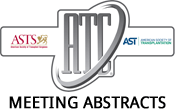2016 American Transplant Congress
Early Hospital Readmisison Among Older Kideny Transplant Recipients.
Surgery, Johns Hopkins University, School of Medicine, Baltimore, MD.
BACKGROUND: We previously established 31% of all kidney transplant (KT) recipients experience early hospital readmission (EHR). We hypothesized that rates of EHR might be higher…2016 American Transplant Congress
An Evaluation of the Safety, Efficacy, and Pharmacoeconomics of Two Valganciclovir Prophylaxis Regimens Following Renal Transplantation.
1IU Health, University Hospital, Indianapolis, IN; 2Butler University, Indianapolis, IN.
Valganciclovir is the preferred prophylactic therapy for the prevention of CMV in transplant recipients and is the most expensive medication required post transplantation. The objective…2016 American Transplant Congress
The Phenotypic Diversity of Late Silent Antibody-Mediated Rejection.
Study purpose: ABMR is a driving force of long-term allograft loss in organ transplantation. The present study was designed to characterize the phenotypic diversity of…2016 American Transplant Congress
Long Term Outcomes Following Antibody Mediated Rejection (AMR) in Renal Transplant Recipients.
Columbia University, New York.
INTRO: Progress in AMR treatment has improved early graft survival. Since the new kidney allocation system results in more sensitized patients getting transplanted, we expect…2016 American Transplant Congress
The Epidemiology of Clostridium difficile Infection in a National Kidney Transplant Center.
BackgroundKidney transplant recipients (KTRs) are at increased risk of Clostridium difficile infection (CDI). We aimed to retrospectively describe the epidemiology of CDI in a national…2016 American Transplant Congress
Conversion to Belatacept as Rescue Therapy in Kidney Transplant Recipients with Severe Graft Dysfunction.
Belatacept is a fusion protein that prevents T cell co-stimulation via the CD28 receptor. If used as first-line therapy, immunosuppression with Belatacept is associated with…2016 American Transplant Congress
Donor-Specific Antibodies in a Single-Center Pediatric Kidney Transplant Population – Incidence and Risk Factors.
In mid-2015, we implemented donor-specific antibody (DSA) monitoring in our pediatric kidney transplant recipient (pKTR) population as recommended (Transplantation 2013;95:19-). We now cross-sectionally analyzed our…2016 American Transplant Congress
Incidence of Polyoma Virus Associated Nephropathy in a Single Transplant Center Employing a Reduction of Immunosuppression at a Lower Threshold of BK Viremia.
Internal Medicine, Infectious Diseases, Yale University, New Haven, CT.
BackgroundPolyoma virus associated nephropathy (PyVAN) caused by BK virus (BKV) is a major complication occurring in 1-10% of renal transplant recipients. Screening and reduction of…2016 American Transplant Congress
Risk Factors for Single and Recurrent Symptomatic Urinary Tract Infections within the First Year After Kidney Transplantation.
Henry Ford Hospital, Detroit, MI.
Urinary Tract Infection (UTI) is the most common infection after kidney transplantation (KT). However studies have been incongruent regarding risk factors associated with incidence and…2016 American Transplant Congress
Clinical Significance of Mycophenolic Acid Therapeutic Drug Monitoring in Kidney Transplant Recipients.
Department of Internal Medicine, Kyungpook National University School of Medicine, Daegu, Korea.
Background: Mycophenolic acid (MPA) is a widely used immunosuppressant to prevent acute rejection in kidney transplant recipients (KTRs). However, clinical significance of MPA therapeutic drug…
- « Previous Page
- 1
- …
- 461
- 462
- 463
- 464
- 465
- …
- 531
- Next Page »
